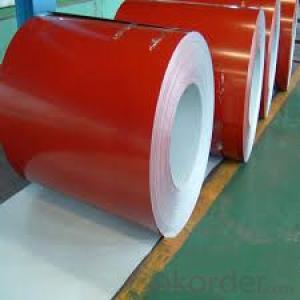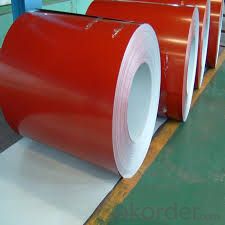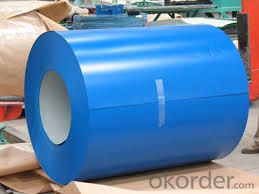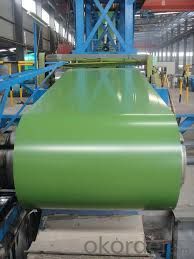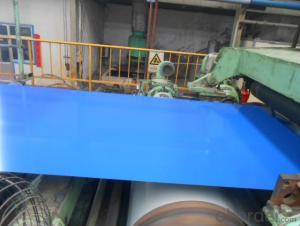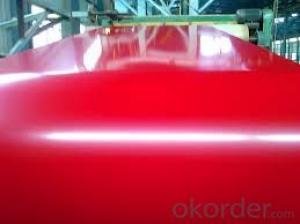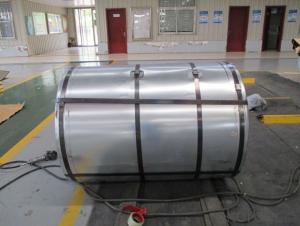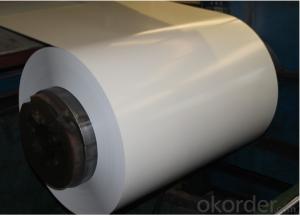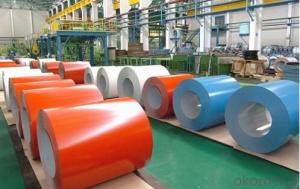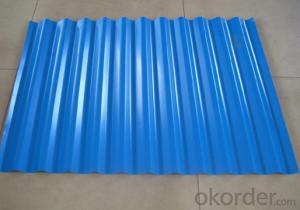Hot Rolled Printed PPGI Prepainted Galvanized Steel Sheet For Roofing
- Loading Port:
- Shanghai
- Payment Terms:
- TT OR LC
- Min Order Qty:
- 20 m.t.
- Supply Capability:
- 10000 m.t./month
OKorder Service Pledge
OKorder Financial Service
You Might Also Like
Product Description
Product | Galvanized | PPGI | Contour plate
| Camouflage plate | |
Certificate | ISO9001,ISO14001 | ||||
Standard | ASTM A526 JIS G3302 | ASTM A525 JIS G3312/3322 | - - | - - | |
Gade | CGCC/CGLCC CGCH/CGLCH CGC340-570 CGLC400-570 | SGCC/CS/DX51D SGCH | - - - - | - - - - | |
Model | Thick:0.11-1.0mm Width:600-1250mm | Thick:0.14-3.5mm Width:600-1250mm | Thick:0.14-3.0mm Width:600-1250mm | Thick:0.14-3.5mm Width:600-1250mm | |
Type | Roil/Coil Sheet/Plate Corrugated Sheet | Roil/Coil Sheet/Plate Corrugated Sheet |
Corrugated Sheet | Roil/Coil Sheet/Plate Corrugated Sheet | |
Coil Weight | 3-8t | ||||
Surface Finish | Regular Spangle | Pre-painted | Pre-painted | Pre-painted | |
Application | Roofing,Structural,Commercial use,Household Applicnce,Industry,Others | ||||
Special Application
| Wear resdentant steel,High-strength-steel plate | ||||
| Name | GI / GL / PPGI / PPGL |
| Full name | Galvanized ,Galvalume,Pre-paited galvanizing,Pre-paited galvalume |
| Basic material | Cold Roll |
| Color of the PPGI and PPGL | Any color in RAL |
| Standard | AISI, ASTM, BS, DIN, GB, JIS |
| Spangle | Normal / Min / Zero |
| Brand Name | |
| Thickness | 0.6mm |
| Width | 600mm to 1250mm |
| Length | According to customers |
| Surface Treatment | Hop-dipped Galvanized |
| AZ coating | 50-275g/m2 |
| Spangle | Normal/Min/Zero |
| Minimum order | 25 Metric Tons |
| Place of Origin | Shandong, China(Mainland) |
| Packing | Fully Applicable for exporting seaworthy packing of horizontal type on wooden skids |
| Price terms | FOB Qingdao |
| Terms of payment | T/T, L/C or T/T and L/C |
| Delivery Detail | within 7-25 days after receiving pre-payment (as per the order quantity) |
| Coil ID | 508mm/610mm |
| Coil Weight | 3-5 tons |
| Supply Ability | 30000MT per month |
| Application | Construction Structure, roofing, commercial use, household appliance, industry- |
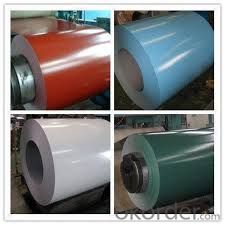
- Q: What are the benefits of using coated steel coils in roofing applications?
- Using coated steel coils in roofing applications offers several advantages. Firstly, the steel coils are highly durable and provide excellent resistance against corrosion. The coatings act as a barrier, protecting the metal from moisture, chemicals, and harsh weather conditions. This ensures that the roofing system remains intact and functional for a long time, reducing the need for frequent repairs or replacements. Secondly, coated steel coils offer superior strength and structural integrity. Steel is known for its high tensile strength, and when combined with the protective coating, it becomes even more resilient. This makes coated steel coils an ideal choice for roofing applications, as they can withstand heavy loads, extreme temperatures, and strong winds without compromising the structure's integrity. Additionally, coated steel coils are lightweight, making them easy to handle and install. This saves time and effort during the roofing process and reduces the overall weight of the structure, minimizing stress on the building's foundation. Furthermore, coated steel coils come in a variety of colors and finishes, allowing for greater design flexibility. Architects and homeowners can choose from a wide range of options to enhance the building's aesthetics. The coatings also provide enhanced UV resistance, preventing color fading and ensuring the roofing system maintains its appearance over time. Lastly, using coated steel coils in roofing applications is an environmentally friendly choice. Steel is highly recyclable, and the coatings used on the coils can be formulated to be environmentally friendly as well. This reduces the carbon footprint associated with construction and promotes sustainability. In conclusion, the benefits of using coated steel coils in roofing applications include durability, strength, lightweight, design flexibility, and environmental sustainability. These advantages make coated steel coils a reliable and cost-effective choice for any roofing project.
- Q: Are steel coils used in HVAC systems?
- Yes, steel coils are commonly used in HVAC systems. They are used in air conditioning units and heat pumps to transfer heat between the refrigerant and the surrounding air, thereby cooling or heating the space. Steel coils are efficient in heat exchange due to their high thermal conductivity and durability.
- Q: What are the common manufacturing defects in steel coils?
- Common manufacturing defects in steel coils include surface defects such as scratches, pits, and dents, as well as internal defects like inclusions, cracks, and voids. Other common defects can include uneven thickness, waviness, and coil set.
- Q: i wanna know all the similarities between iron and steel
- Steel is an iron alloy which contains between 0.2 percent and 2.0% carbon. Modern steels nearly always contain 0.5% - 1% manganese as well. (though technically the manganese doesn't need to be present for it to be considered steel.) Above 2.1% is usually called cast iron. Cast iron is brittle, but has a lower melting point than steel. Below 0.2% percent carbon is considered commercially pure iron. Pure iron is soft and malleable like copper, but it has low strength. Adding small amounts of carbon increases it's strength dramatically.
- Q: Can solution annealing be done on carbon and low alloy steels. please give an explanatory answer.
- No. Carbon steel has two different crystal structures, FCC and BCC , depending on the temperature. when you heat steel up and then quench it, it locks the crystal structure into the BCC form. this makes it hard. whereas precipitation hardened austentic stainlesses remain BCC regardless of the temp, so the hardness change is not a function of thermally induced strain. you can anneal carbon steel but the thermal profile is closer to the precipitation profile of PH stainlesses than it is to the Solution annealing profile.
- Q: How are steel coils used in the production of power generation equipment?
- Steel coils are used in the production of power generation equipment as they are shaped and formed into various components such as turbine casings, generator frames, and steam pipes. These coils provide the necessary strength and durability to withstand the high temperatures, pressure, and mechanical stresses involved in power generation processes. Additionally, steel coils are often coated with protective layers to prevent corrosion, ensuring the longevity and reliability of the equipment.
- Q: the difference between the original steel and mild steel from percentage of carbon
- Carbon steel includes mild steel. Mild carbon steel(as it is referred to) contains .05 - .29% carbon. Medium carbon steel is from .30 - .59%. High carbon steel is from .60 - .99%. Ultra high carbon steel is from 1.00 - 2.00%. Steel is considered carbon steel up to 2.1%. Past that it is considered cast iron. The more carbon in the steel the harder and less ductile and maleable it is and also the more brittle it is. The less carbon in the steel more it will bend and shape without breaking. So in essence carbon adds strength but takes away from its elasticity. If you are interested in this subject an interesting source is swordmaking where hardness(carbon content) is crucial. The information behind this subject is pretty infinite.
- Q: Help please.What atoms are there in steel?Like water is equals to 1 Oxygen atom + 2 Hydrogen atoms.Thnx 4 d help.
- Steel is mostly iron with a small amount (less than 1%) of carbon added. Stainless steel has other metals like chromium and nickel added.
- Q: I'm analysing horse stirrups and would like to know the disadvantages to stainless steel? - thanks
- For horse stirrups the main disadvantage to stainless steel is the manufacturing cost. Stainless steels tend to work harden, and are subject to their own peculiar forms of corrosion, but I see little implication to either of these factors when used as a stirrup iron or a safety latch. Stainless steel is also subject to self welding, or galling, this would be of no concern for the irons, but could result in the pivot of the safety latch freezing (I have never known anyone to ride with the safety latch closed, however).
- Q: What are the different methods of coil edge trimming?
- Various industries commonly use several methods for coil edge trimming. These methods include: 1. Shearing: Cutting the edges of the coil is accomplished using a shear blade. Shearing is a popular technique for thick coils and can be done manually or with a machine. It provides a clean and straight cut but may not be suitable for thin or delicate materials. 2. Slitting: In this process, the coil is passed through slitter knives that make multiple cuts along the edge, creating narrower strips. Slitting is commonly used for producing narrow coils or strips of various widths. It can be done in-line with a coil processing line or as a separate standalone process. 3. Laser cutting: A precise method of coil edge trimming, laser cutting employs a high-powered laser beam to cut through the material. It offers high accuracy and flexibility for cutting complex shapes or patterns. Laser cutting is commonly used for thin or delicate materials, minimizing the risk of deformation or damage caused by other cutting methods. 4. Plasma cutting: Plasma cutting is a thermal cutting process that employs a plasma torch to cut through the coil. It is suitable for cutting a wide range of materials, including thick coils. Plasma cutting is known for its high cutting speed and ability to cut through materials with high melting points, such as stainless steel or aluminum. 5. Waterjet cutting: This method utilizes a high-pressure jet of water mixed with an abrasive material to cut through the coil. It is a versatile technique that can cut a wide range of materials and thicknesses. Waterjet cutting provides a smooth and precise cut without heat-affected zones, making it suitable for sensitive materials. 6. Guillotine cutting: Guillotine cutting involves using a guillotine-style blade to cut through the coil. It is a quick and efficient method that provides a straight cut. Guillotine cutting is commonly used for cutting coils of various thicknesses and is often performed with a machine for higher precision. Each method of coil edge trimming has its own advantages and considerations depending on the specific requirements of the application. The choice of method usually depends on factors such as material properties, thickness, desired cutting accuracy, production volume, and budget constraints.
Send your message to us
Hot Rolled Printed PPGI Prepainted Galvanized Steel Sheet For Roofing
- Loading Port:
- Shanghai
- Payment Terms:
- TT OR LC
- Min Order Qty:
- 20 m.t.
- Supply Capability:
- 10000 m.t./month
OKorder Service Pledge
OKorder Financial Service
Similar products
Hot products
Hot Searches
Related keywords
